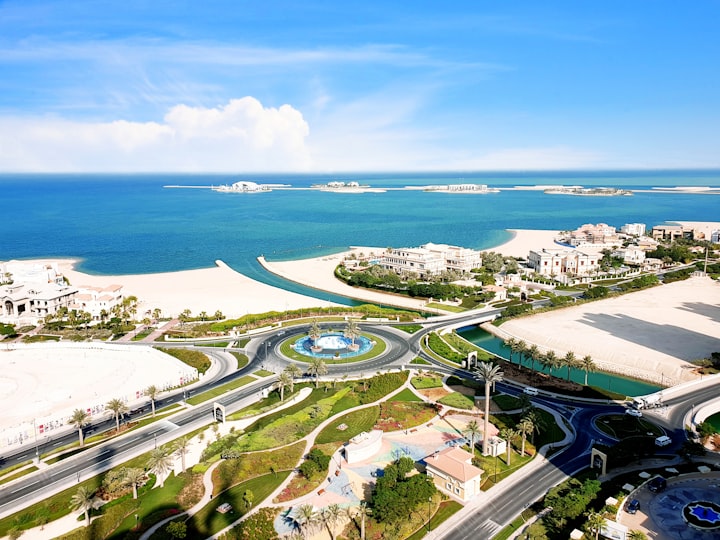
The history of Qatar spans from its first duration of human occupation to its formation as a modern state. Human occupation of Qatar dates back to 50,000 years ago, and Stone Age encampments and tools have been unearthed in the Arabian Peninsula.[1] Mesopotamia was the first civilization to have a presence in the area during the Neolithic period, evidenced by the discovery of potsherds originating from the Ubaid period near coastal encampments.[2]
The peninsula fell under the domain of several different empires during its early years of settlement, including the Seleucid, the Parthians and the Sasanians. In 628 AD, the population was introduced to Islam after Muhammad sent an envoy to Munzir ibn Sawa who was the Sasanid governor of Eastern Arabia.[3] It became a pearl trading center by the 8th century.[4] The Abbasid era saw the rise of several settlements.[5] After the Bani Utbah and other Arab tribes conquered Bahrain in 1783, the Al Khalifa imposed their authority over Bahrain and mainland Qatar. Over the following centuries, Qatar was a site of contention between the Wahhabi of Najd and the Al Khalifa. The Ottomans expanded their empire into Eastern Arabia in 1871,[6] withdrawing from the area in 1915 after the beginning of World War I.
In 1916, Qatar became a British protectorate and Abdullah Al Thani signed a treaty stipulating that he could only cede territory to the British in return for protection from all aggression by sea and support in case of a land attack. A 1934 treaty granted more extensive protection.[7] In 1935, a 75-year oil concession was granted to QatarEnergy and high-quality oil was discovered in 1940 in Dukhan.[7]
During the 1950s and 1960s, increasing oil revenues brought prosperity, rapid immigration, substantial social progress, and the beginnings of the country's modern history. After Britain announced a policy of ending the treaty relationships with the Persian Gulf sheikdoms in 1968, Qatar joined the other eight states then under British protection in a plan to form a federation of Arab emirates. By mid-1971, as the termination date of the British treaty relationship approached, the nine still had not agreed on terms of union. Accordingly, Qatar declared its independence on September 3, 1971.[7] In June 1995, deputy emir Hamad bin Khalifa became the new emir after his father Khalifa bin Hamad in a bloodless coup. The emir permitted more liberal press and municipal elections as a precursor to parliamentary elections. A new constitution was approved via public referendum in April 2003 and came into effect in June 2005.[7]
Prehistory
Edit
See also: Archaeology of Qatar
Paleolithic Age
Edit
In 1961, a Danish archaeological expedition carried out on the peninsula uncovered approximately 30,000 stone implements from 122 paleolithic sites. Most of the sites were situated along the coastline, and were divided into four separate cultural groups based on flint typology. Macrolithic tools such as scrapers, arrowheads and hand axes dating to the lower and middle paleolithic periods were among the discoveries.[8]
The flooding of the Persian Gulf, which occurred roughly 8,000 years ago,[9] resulted in the displacement of Persian Gulf inhabitants, the formation of the Qatari Peninsula and the occupation of Qatar to capitalize on its coastal resources.[10] From this time onward, Qatar was regularly used as rangeland for nomadic tribes from the Najd and al-Hasa regions in Saudi Arabia, and a number of seasonal encampments were constructed around sources of water.[11]
Neolithic period (8000–3800 BC)
Edit
Al Da'asa, a settlement located on the western coast of Qatar, is the most extensive Ubaid site in the country. It was excavated by the 1961 Danish team.[12] The site is theorized to have accommodated a small seasonal encampment, possibly a lodging for a hunting-fishing-gathering group who made recurrent visits.[13] This is evidenced by the discovery of nearly sixty fire pits at the site, which may have been used to cure and dry fish, in addition to flint tools such as scrapers, cutters, blades and arrow heads. Furthermore, many painted Ubaid potsherds and a carnelian bead were found in the fire pits, suggesting overseas connections.[14]
In an excavation done in Al Khor in 1977–78, several Ubaid-period graves were uncovered in what is considered the earliest recorded burial site in the country.[15] One grave contained the cremated remains of a young woman with no grave goods. Eight other graves contained grave goods, including beads made of shell, carnelian and obsidian. The obsidian most likely originated from Najran in south west Arabia.[12][14]
Bronze Age (2100–1155 BC)
Edit
See also: Dilmun and Kassites
Al Khor Island, the location of the purple dye industry
The Qatari Peninsula was close enough to the Dilmun civilization in Bahrain to have felt its influence.[1] Barbar pottery was excavated in two sites by the Qatar Archaeology Project, evidencing the country's involvement in Dilmun's trade network.[12] When the people of Dilmun began engaging in maritime activities around 2100 to 1700 BC, the inhabitants of Qatar started diving for pearls in the Persian Gulf.[16] The Qataris were engaged in the trading of pearls and date palms during this era.[17]
It has been argued that the remains of Dilmun settlements found in Qatar do not represent major evidence of long-term human habitation.[13] Qatar remained largely uninhabited during this period due to regular migration by nomadic Arab tribes searching for untapped sources of food and water.[18] The settlements dating to the Dilmun period, particularly in Al Khor Island, may have been established to expedite trade journeys between Bahrain to the closest significant settlement in the Persian Gulf, Tell Abraq. Another scenario entails that the encampments were created by visiting fishermen or pearl fishers from Dilmun. It has also been suggested that the presence of pottery is indicative of trade between the inhabitants of Qatar and the Dilmun civilization, though this is considered unlikely due to the scarce population of the peninsula during this period.[19]
Kassite Babylonian-influenced materials dating back to the second millennium BC, which were found in Al Khor Island, reveal evidence of trade relations between the inhabitants of Qatar and the Kassite.[11] Among the findings were 3,000,000 crushed snail shells and Kassite potsherds.[12] It has been asserted that Qatar was the site of the earliest known production of shellfish dye owing to a purple dye industry operated by the Kassite which existed on the island.[2][20] The dye was obtained from the Murex snail and was known as "Tyrian purple".[12] Dye production may have been supervised by the Irtaza the great in Bahrain with the purpose of exporting the dye to Mesopotamia.[21]





Comments
There are no comments for this story
Be the first to respond and start the conversation.